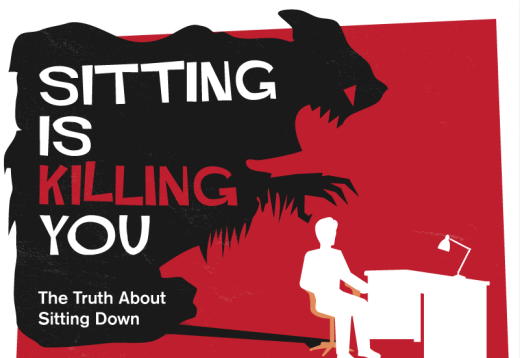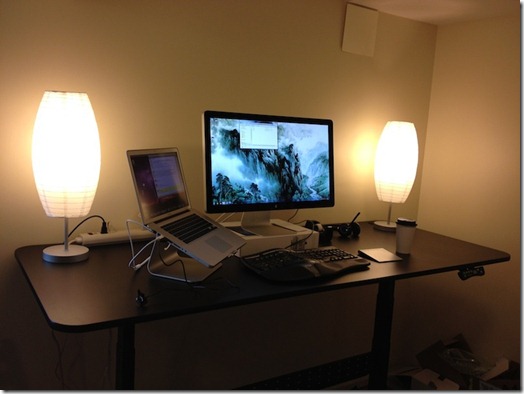Sitting is Making You Fat and Killing You
As a kid, I was an impatient little brat. On any occasion that required waiting, I became Squirmy Wormy until I pushed my dad to make the demand parents so often make of fidgety kids, “Sit still!”
Recent evidence suggests a rejoinder to kids today in response to this command, “What!? Are you trying to kill me?!”
There is compelling evidence that modern workers propensity to sit for prolonged periods every day makes them fat and shortens their lives. Hmmm, you wouldn’t happen to know any professions where sitting limply at a desk for long periods of time is common, would you?
Yeah, me too.
This spurred me to learn more which led me to The Daily Infographic’s great summary of this research. Seriously, click on the image below. I could have stopped there and called it a post. But as always, I don’t know when to stop.
Much has been written about the detrimental health effects of inactivity. According to Marc Hamilton, a biomedical researcher, sitting down shuts off your fat burning.
Physiologists analyzing obesity, heart disease, and diabetes found that the act of sitting shuts down the circulation of a fat-absorbing enzyme called lipase.
The same Hamilton goes into more details in this interesting NY Times article on the potential lethality of prolonged sitting,
This is your body on chairs: Electrical activity in the muscles drops — “the muscles go as silent as those of a dead horse,” Hamilton says — leading to a cascade of harmful metabolic effects. Your calorie-burning rate immediately plunges to about one per minute, a third of what it would be if you got up and walked.
In other words, sitting down is the off button.
This LifeHacker article points out that the the long term health effects of sitting multiple hours a day go way beyond weight gain.
After 10-20 Years of Sitting More Than Six Hours a Day
Sitting for over six hours a day for a decade or two can cut away about seven quality adjusted life years (the kind you want). It increases your risk of dying of heart disease by 64 percent and your overall risk of prostate or breast cancer increases 30 percent.
I want all kinds of life years, but the “quality adjusted” variety sounds extra special.
You might think that you’ll be just fine because you exercise the recommended 30 minutes a day, but a study from the British Journal of Sports Medicine notes that’s not the case.
Even if people meet the current recommendation of 30 minutes of physical activity on most days each week, there may be significant adverse metabolic and health effects from prolonged sitting—the activity that dominates most people’s remaining “non-exercise” waking hours.
That’s particularly disheartening. All that other exercise you do might not counteract all the prolonged sitting.
Get up, stand up! Stand up for your code!
With apologies to Bob Marley
So what’s a developer to do? Note that these studies put an emphasis on prolonged. The simple solution is to stop sitting for prolonged periods at a time. Get up at least once an hour and move!
But developers are interesting creatures. We easily get in the zone on a problem and focus so deeply that three hours pass in a blink. Ironically this wasn’t a problem I faced as a Program Manager since I was moving from meeting to meeting nearly every hour.
But in my new job, writing code at home, I knew I needed more than an egg timer to tell me to move every hour. I want to move constantly if I can. For example, the way you do when you stand. So I looked into adjustable desks.
According to Alan Hedge, director of Cornell’s Human Factors and Ergonomics laboratory, workers fare better when using adjustable tables (emphasis mine).
We found that the computer workers who had access to the adjustable work surfaces also reported significantly less musculoskeletal upper-body discomfort, lower afternoon discomfort scores and significantly more productivity,” said Alan Hedge, professor of design and environmental analysis in the College of Human Ecology at Cornell and director of Cornell’s Human Factors and Ergonomics Laboratory.
So I went on a quest to find the perfect adjustable desk. How did I choose which desk to purchase?

Critical hit!
Photo
by
disoculated
from Flickr Ok, not quite. I might have put in a little more research
into it than that.
I asked around the interwebs and received a lot of feedback on various options. I found two desk companies that stood out: Ergotron and GeekDesk.
Initially, I really liked the Ergotron approach. Rather than a motorized system for moving the desk up and down, it has a clever quick release lever system that makes it easy to adjust the desk’s height quickly without requiring any tools or electricity.
For this reason, I initially settled on the Workfit-D Sit Stand Desk. Unfortunately, Ergotron is a victim of its own success in this particular case. They were backordered until our sun grows into a red giant and engulfs the planet and I couldn’t wait that long.
So I ended up ordering the GeekDesk Max. This desk uses a motor to adjust to specific heights, but has four presets. This is important because without the presets, you’re sitting there holding the button until it reaches the height you want. While the motor is slower than the Ergotron approach, with the presets, I can just hit the button and go get a coffee. To be fair, it’s not all that slow. Did I mention I’m impatient?
I’m very happy with this desk. Here’s a photo of my workspace that I sent to CoderWall with the desk in a standing configuration.
If you are looking for a more inexpensive option, I recently learned about this Adjustable Keyboard Podium that seems like a good option. Jarrod, a StackOverflow developer, uses it in his office.
As far as I can find, there’s only one study that points to a potential negative health impact from standing at work. http://www.ncbi.nlm.nih.gov/pubmed/10901115
Significant relationships were found between the amount of standing at work and atherosclerotic progression.
However, as you might expect, this one study is not conclusive and doesn’t focus solely on the work habits of office workers who stand. From what I can tell so far, the health benefits far outweigh the detriments assuming you don’t over do it.
If you do stand at work, I highly recommend getting some sort of gel or foam padding to stand on. Especially if you’re not wearing shoes. The hard floor might seem fine at first because you’re a tough guy or girl, but over the course of a day, it’ll feel like someone’s taken a bat to your soles.
Also, vary it up throughout the day. Don’t stand all day. Take breaks where you work sitting down and alternate.
Fight malaise!
Not every developer is the same, clearly. Some are fit, but many, well, let’s just say that the health benefits mentioned in this post might not factor into their decision making.
James Levine, a researcher at the Mayo clinic, had a more philosophical point to make about sitting all day that goes beyond just the physical health benefits. He also sees a mental health benefit.
For all of the hard science against sitting, he admits that his campaign against what he calls “the chair-based lifestyle” is not limited to simply a quest for better physical health. His is a war against inertia itself, which he believes sickens more than just our body. “Go into cubeland in a tightly controlled corporate environment and you immediately sense that there is a malaise about being tied behind a computer screen seated all day,” he said. “The soul of the nation is sapped, and now it’s time for the soul of the nation to rise.”
http://www.nytimes.com/2011/04/17/magazine/mag-17sitting-t.html
In other words, stop sitting and write better code! Go forth and conquer.


Comments
28 responses